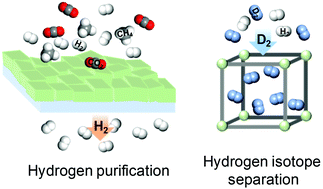Hydrogen separation and purification with MOF-based materials
Abstract
Hydrogen (H2) has been receiving considerable attention as a promising future energy source owing to its high energy density and eco-friendly features. Nonetheless, H2 production, utilization, and storage involve many technical challenges, which must be overcome to realise a sustainable hydrogen economy. In particular, the high purity of H2 is important for its utilization as a clean fuel, so energy- and cost-efficient purification processes and materials are essential. In addition, the separation of valuable hydrogen isotopes such as deuterium (D) and tritium (T), which have similar physicochemical properties, is not only challenging but also significant because of the high demand for these isotopes in industrial, medical, and scientific research but their low natural occurrence. Recently, porous crystalline metal–organic frameworks (MOFs) have emerged as a promising candidate for H2 purification and isotope separation owing to their designable porosity and functionality, which affect their molecular sieving effect and the kinetic and/or chemical affinity quantum sieving effects. Their rational design and synthesis with a judicious choice of metal ions and organic ligands provide the desired properties and functionality, resulting in a controlled structural topology, pore size, shape, and surface polarity. This review is intended to provide a comprehensive understanding of the fundamental theories and strategies for MOF-based H2 separation and purification, including hydrogen isotope separation with representative examples.

- This article is part of the themed collections: Functional materials for sustainable future - Vision from Korean scientists and 2021 Materials Chemistry Frontiers Review-type Articles


 Please wait while we load your content...
Please wait while we load your content...